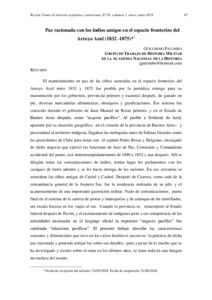Por favor, use este identificador para citar o enlazar este ítem:
https://repositorio.uca.edu.ar/handle/123456789/6682| Título: | Paz racionada con los indios amigos en el espacio fronterizo del Arroyo Azul (1832-1875) | Autor: | Palombo, Guillermo | Palabras clave: | HISTORIA ARGENTINA; PUEBLOS ORIGINARIOS; ABORIGENES ARGENTINOS; PAZ | Fecha de publicación: | 2018 | Editorial: | Pontificia Universidad Católica Argentina. Facultad de Ciencias Sociales. Departamento de Historia. Centro de Historia Argentina y Americana | Cita: | Palombo, G. Paz racionada con los indios amigos en el espacio fronterizo del Arroyo Azul (1832-1875) [en línea]. Temas de Historia Argentina y Americana. 2018, 26(1). Disponible en: https://repositorio.uca.edu.ar/handle/123456789/6682 | Resumen: | Resumen: El mantenimiento en paz de las tribus asentadas en el espacio fronterizo del Arroyo Azul entre 1832 y 1875 fue posible por la periódica entrega para su manutención por los gobiernos, provincial primero y nacional después, de ganado en pie, diversas mercaderías alimenticias, obsequios y gratificaciones. Ese sistema fue conocido durante el gobierno de Juan Manuel de Rosas primero, y en el Estado de Buenos Aires después, como “negocio pacífico”. Al pueblo y fortaleza de Azul, aparente por su situación geográfica –en el corazón de la provincia de Buenos Aires– y proximidad al territorio indígena, llegaban las embajadas tanto de Salinas Grandes como las procedentes de Chile para tratar con el capitán Pedro Rosas y Belgrano, encargado de dicho negocio que ejerció las funciones de Juez de Paz, Comisario y Comandante accidental del punto, casi ininterrumpidamemente de 1840 a 1852 y aun después. Allí se dirigían todas las comunicaciones de indios, tenían lugar los parlamentos con los caciques de tierra adentro y se les hacía entrega de las raciones. En sus cercanías se asentaban las tribus amigas de Catriel y Cachul. Después de Caseros, como sede de la comandancia general de la frontera Sur, fue la residencia ordinaria de su jefe, y el acantonamiento de una importante guarnición militar. Nudo de comunicaciones, punto final en el sistema de la carrera de postas y mensajerías y de arranque de las rastrilladas, era escala forzosa en los viajes al sur. Cuando la provincia se reincorporó al Estado federal después de Pavón, y el racionamiento de indígenas pasó a ser competencia de las autoridades nacionales en el lenguaje oficial la expresión “negocio pacífico” fue sustituida “relaciones pacíficas”. El presente trabajo describe las características comunes y diferenciales que tuvo en los ciclos históricos sucesivos la práctica de dicha paz racionada y pretende arrojar luz sobre sus detalles, pues a pesar de lo mucho que se ha investigado y escrito sobre el tema en los últimos años, se tiene todavía una imagen inconclusa del asunto. Abstract: The maintenance in peace of the tribes settled in the border area of Arroyo Azul between 1832 and 1875 was possible by the periodic delivery for maintenance by the governments, first and national provincial afterwards, of live cattle, various foodstuffs, gifts and gratuities . That system was known during the government of Juan Manuel de Rosas first, and in the State of Buenos Aires later, as "peaceful business". To the town and fortress of Azul, apparent by its geographical location -in the heart of the province of Buenos Aires- and proximity to the indigenous territory, arrived the embassies of both Salinas Grandes and those coming from Chile to deal with Captain Pedro Rosas and Belgrano , in charge of said business that exercised the functions of Justice of the Peace, Commissioner and accidental Commander of the point, almost uninterruptedly from 1840 to 1852 and even later. There all the communications of Indians were directed, the parliaments with the caciques of inland took place and the rations were given to them. Nearby were the friendly tribes of Catriel and Cachul. After Caseros, as the headquarters of the general command of the southern border, was the ordinary residence of his boss, and the cantonment of a major military garrison. Knot of communications, final point in the system of the race of posts and couriers and of start of the rakes, was forced scale in the trips to the south. When the province rejoined the federal State after Pavón, and the rationing of indigenous people became the competence of the national authorities in the official language, the expression "peaceful business" was replaced by "peaceful relations". The present work describes the common and differential characteristics that the practice of said rationed peace had in the successive historical cycles and intends to shed light on its details, because in spite of how much has been researched and written on the subject in recent years, There is still an unfinished image of the matter. |
Cobertura Espacial: | Buenos Aires (Argentina : provincia) | URI: | https://repositorio.uca.edu.ar/handle/123456789/6682 | ISSN: | 2618-1924 (online) 1666-8146 |
Disciplina: | HISTORIA | Derechos: | Acceso Abierto | Fuente: | Temas de Historia Argentina y Americana. 2018, 26(1) |
| Aparece en las colecciones: | TEM - 2018 nro. 26 vol 1 |
Ficheros en este ítem:
| Fichero | Descripción | Tamaño | Formato | |
|---|---|---|---|---|
| 1411-4939-1-PB.pdf | 481,07 kB | Adobe PDF |  Visualizar/Abrir |
Visualizaciones de página(s)
314
comprobado en 30-abr-2024
Descarga(s)
324
comprobado en 30-abr-2024
Google ScholarTM
Ver en Google Scholar
Este ítem está sujeto a una Licencia Creative Commons

